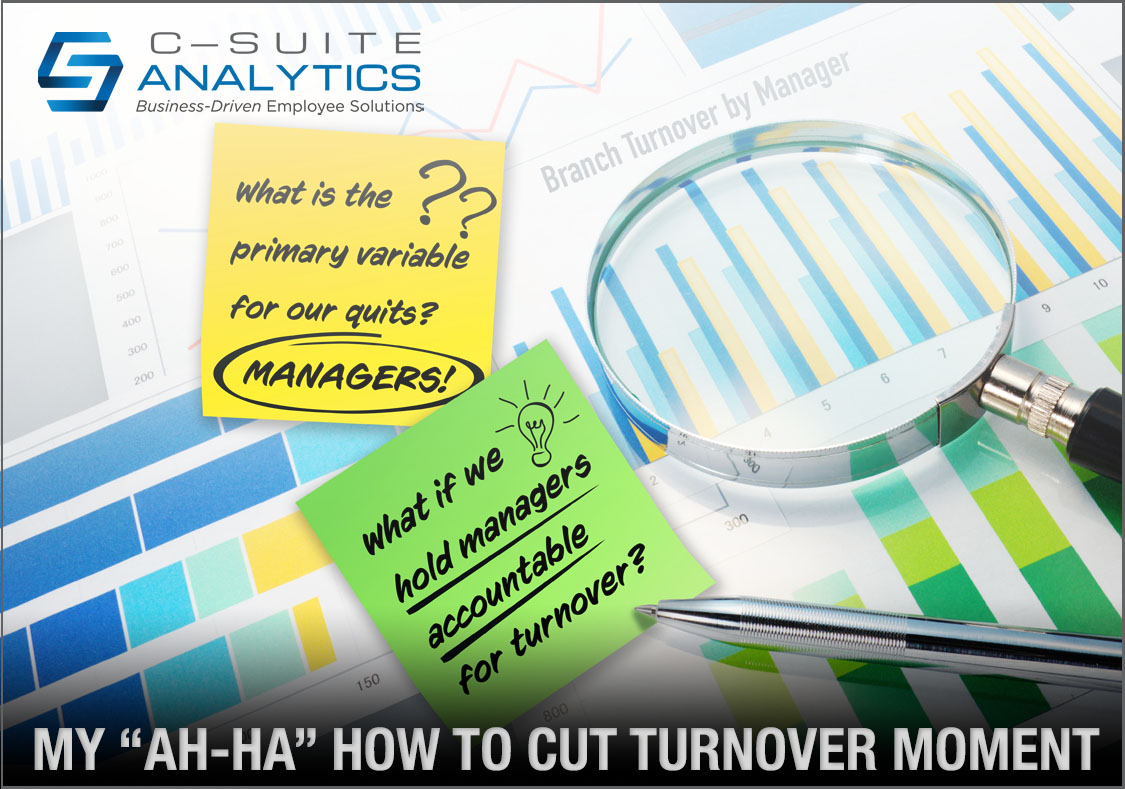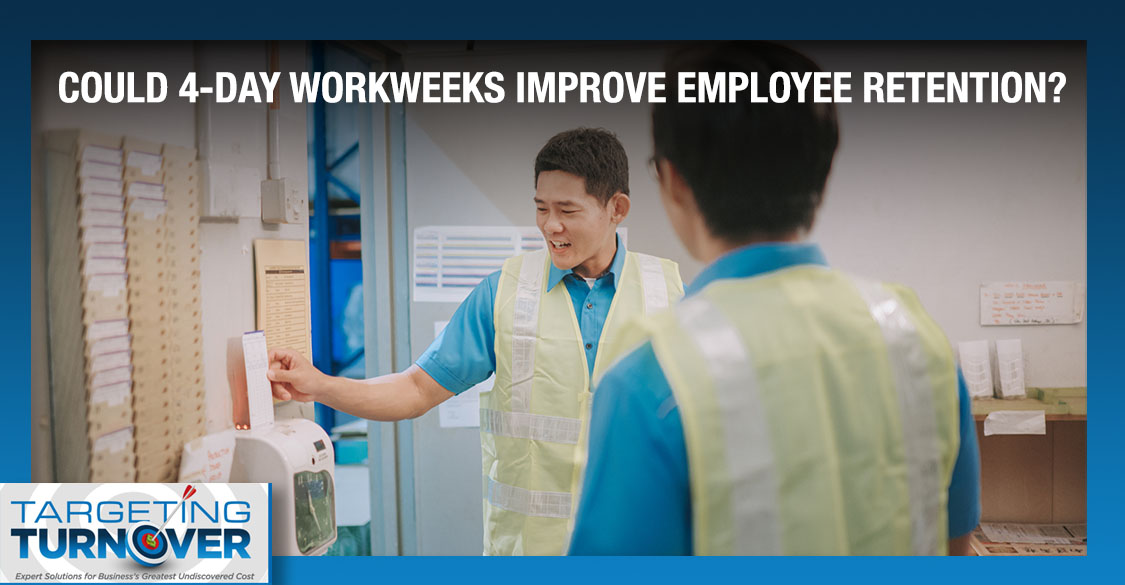Data shows a four-day workweek is popular with employees. On the company side, data suggests work satisfaction and productivity are up, recruiting is easier…and employee turnover is down. And during these days workforce shortages, every company is seeking a recruiting edge. Could this be “it”?
My “‘Ah-Ha” How to Cut Turnover Moment

My professional passion to invent the only research-based solution to cut employee turnover began with one experience, conducted a few decades ago. And it began with my CEO saying words that HR professionals dread: “Turnover is high so HR, go fix it.”
Where Did I Start Addressing Turnover?
The scene was a large regional banking company, and the CEO was responsible for 70 branches in Florida. He had been commanded by his board of directors to cut turnover and had little instinct for why employees quit or how to fix it. So he passed his own feelings of being threatened by a higher authority onto me, given I was the top HR exec so surely I had an improve-retention wand back in my office.
But there was no room for humor here. I was accountable for solving the company’s #1 problem according to our board, and my success would become the CEO’s success. Or his failure which, as they say, was not an option. Sound familiar?
After hearing my orders, I immediately went home to update my resume. No joke. I remember the green couch I was sitting on to this day. Little did I realize, though, that I was about to take part in a nearly ideal research experiment.
Unlike today, those were the times when customers had to travel to a branch to conduct most banking services. But the physical and functional architecture of our 70 branch banks was the same as now. The shingles and bricks of each building were identical…and so were the jobs, the pay, the benefits, and the furniture. So how could some branches have turnover as high as 70% and others had turnover of just 10%? The one variable…and we could easily argue the only important variable…was the manager.
This Was My “Ah-ha” Turnover Moment
If placed in this circumstance today, most HR execs would turn toward exit survey and engagement survey results, form an employee retention committee, and build a list of company-wide “solutions”. First up might be five steps to improve employee recognition which would be to award an employee of the month, give that winner a premium parking space, sponsor an employee appreciation week, and then ensure each employee received a company merch backpack at five years at a company clock at ten. Or to improve communication one would schedule more town hall meetings and provide a CEO video.
Many of these options were available to me at the time, but I knew I had to look at it from another angle. Instead of one-size-fits all programs, I dug into research on what the variables most impacted turnover based on academic studies versus routinely-published exit interview results. Only then could I determine the right course of action for cutting turnover.
What did I find? The branch manager was the primary variable. The difference between who stayed and who left was based on the direct supervisor. Further research and analysis showed it was actually a smaller sub-set of poor managers who drove our high turnover numbers company-wide.
“Ah-ha.” It wasn’t HR, but was instead the managers who drove turnover and who needed to be measured and held accountable for turnover. What did I do? Exactly what I recommend to this day today. Convert turnover from a percentage to a dollar cost so everyone understands how much each exit actually costs the company to lose just one employee. Gather front-line managers together to give them a measurable goal to reduce employee turnover and hold them accountable to meet it.
Want to convert your turnover percentage to a dollar cost?
Use our Free Turnover Cost Calculator.
The Turnover Accountability Push Back and My Push Forward
When speaking at conferences, this is where I say that the managers immediately offered several “suggestions” and each of those suggestions ended in “sucks”…as in “the pay sucks”, “the benefits suck”, and…well…you get the idea. There were stormy moments, all started when one brave manager raised his hand and said, “Now let me get this straight. You expect us to cut employee turnover?”
Our answer was yes, we did expect those managers to cut employee turnover. And our only offer to “help” was to distribute a monthly report that showed their progress against their goal, and it was a separate report, so this data wasn’t buried alongside other data. We didn’t raise pay, didn’t provide additional training, and we offered no additional benefits.
Looking back, in my mind the idea of holding managers accountable for turnover was really a shot in the dark. It was so different from the sameness of the setting, especially when set against the great gaps in turnover across the state. I didn’t know then that one “ah-ha” moment would lead me on a greater journey including further research with a professor of industrial psychology to help me clarify my ideas into these three bedrocks:
- The number one reason employees stay or leave…or for that matter engage or disengage…is how much they trust their immediate supervisors.
- This does NOT mean that each time an employee quits it is because she doesn’t trust her boss because employees quit for lots of reasons…but it might be because she didn’t trust her boss.
- It DOES mean, though, that each individual leader must become your very best employee retention solution.
I outline more on this in my book titled HR’s Greatest Challenge which provides summaries of 25 studies that back this up.
What Are the Key Takeaways from My Turnover “Ah-ha”?
So 90 days later our turnover had decreased by 19%. In the interim I had worked with finance to conduct a cost study for losing one teller and the result was $4,933 per exit…locked in my memory…resulting in our total savings at that point to equal over $4 million. The board was happy, and I had saved my job.
Looking back, I knew then that I had learned a lesson mostly unknown across HR circles. Simply said, that any retention effort that does not include holding first-line leaders accountable for turnover would be a bust.
Much has happened in my professional life since then, but my passion for this remains rooted in these science-based beliefs and it works. I have seen the results of those who have used my SHRM books to implement Stay Interviews and while working with scores of clients to help them save hundreds of millions of dollars for their companies by cutting turnover. One thing I routinely share in jest when speaking at conferences always gets a chuckle from HR people, but it sums up my passion for this work succinctly: When was the last time you heard a really good worker say, “My boss treats me like dirt, but I’m holding on for employee appreciation week. I’ll get a balloon and a hot dog, and I’ll feel great!!!”



